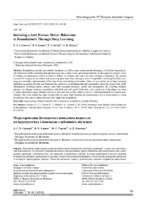| dc.contributor.author | Cervera, A. S. J. | |
| dc.contributor.author | Alonso, F. J. | |
| dc.contributor.author | Garcia, F. S. | |
| dc.contributor.author | Alvarez, A. D. | |
| dc.coverage.spatial | Минск | ru |
| dc.date.accessioned | 2020-02-04T09:43:04Z | |
| dc.date.available | 2020-02-04T09:43:04Z | |
| dc.date.issued | 2020 | |
| dc.identifier.citation | Imitating a Safe Human Driver Behaviour in Roundabouts Through Deep Learning = Моделирование безопасного поведения водителя на перекрестках с помощью глубинного обучения / A. S. J. Cervera [et al.] // Наука и техника. – 2020. – № 1. – С. 85-88. | ru |
| dc.identifier.uri | https://rep.bntu.by/handle/data/63825 | |
| dc.description.abstract | Roundabouts provide safe and fast circulation as well as many environmental advantages, but drivers adopting unsafe behaviours while circulating through them may cause safety issues, provoking accidents. In this paper we propose a way of training an autonomous vehicle in order to behave in a human and safe way when entering a roundabout. By placing a number of cameras in our vehicle and processing their video feeds through a series of algorithms, including Machine Learning, we can build a representation of the state of the surrounding environment. Then, we use another set of Deep Learning algorithms to analyze the data and determine the safest way of circulating through a roundabout given the current state of the environment, including nearby vehicles with their estimated positions, speeds and accelerations. By watching multiple attempts of a human entering a roundabout with both safe and unsafe behaviours, our second set of algorithms can learn to mimic the human’s good attempts and act in the same way as him, which is key to a safe implementation of autonomous vehicles. This work details the series of steps that we took, from building the representation of our environment to acting according to it in order to attain safe entry into single lane roundabouts. | ru |
| dc.language.iso | en | ru |
| dc.publisher | БНТУ | ru |
| dc.title | Imitating a Safe Human Driver Behaviour in Roundabouts Through Deep Learning | ru |
| dc.title.alternative | Моделирование безопасного поведения водителя на перекрестках с помощью глубинного обучения | ru |
| dc.type | Article | ru |
| dc.identifier.doi | 10.21122/2227-1031-2020-19-1-85-88 | |
| local.description.annotation | Кольцевые транспортные развязки обеспечивают безопасное и быстрое движение, а также ряд экологических преимуществ. Но водители, придерживающиеся ненормативных правил поведения при вождении по ним, могут вызвать проблемы с безопасностью, что приводит к несчастным случаям. В статье предлагается способ обучения водителя автономного транспортного средства с целью обеспечения правильного и безопасного поведения при въезде в кольцевую транспортную развязку. Поместив несколько камер в транспортное средство и обработав видеозапись видеопотоков с помощью ряда алгоритмов, включая и машинное обучение, можно получить представление о состоянии окружающей среды. Затем используется другой набор алгоритмов глубокого обучения для анализа данных и определения наиболее безопасного пути кругового движения с учетом текущего состояния окружающей среды, включая ближайшие транспортные средства с их предполагаемым местоположением, скоростью и ускорением. Анализируя многочисленные примеры безопасного и опасного поведения водителя во время движения по кольцевой транспортной развязке, предлагается второй набор алгоритмов, который позволяет моделировать правильное поведение водителя, что и является главным условием безопасного применения автономных транспортных средств. В статье подробно описываются все этапы работы, начиная от построения рассматриваемой окружающей среды и заканчивая соответствующим поведением в зависимости от ситуации, что позволяет обеспечить безопасное движение в кольцевой развязке с одной полосой движения. | ru |

